24 Hours Hotline: +86 137-3541-1378
Email:[email protected]
24 Hours Hotline: +86 137-3541-1378
Email:[email protected]
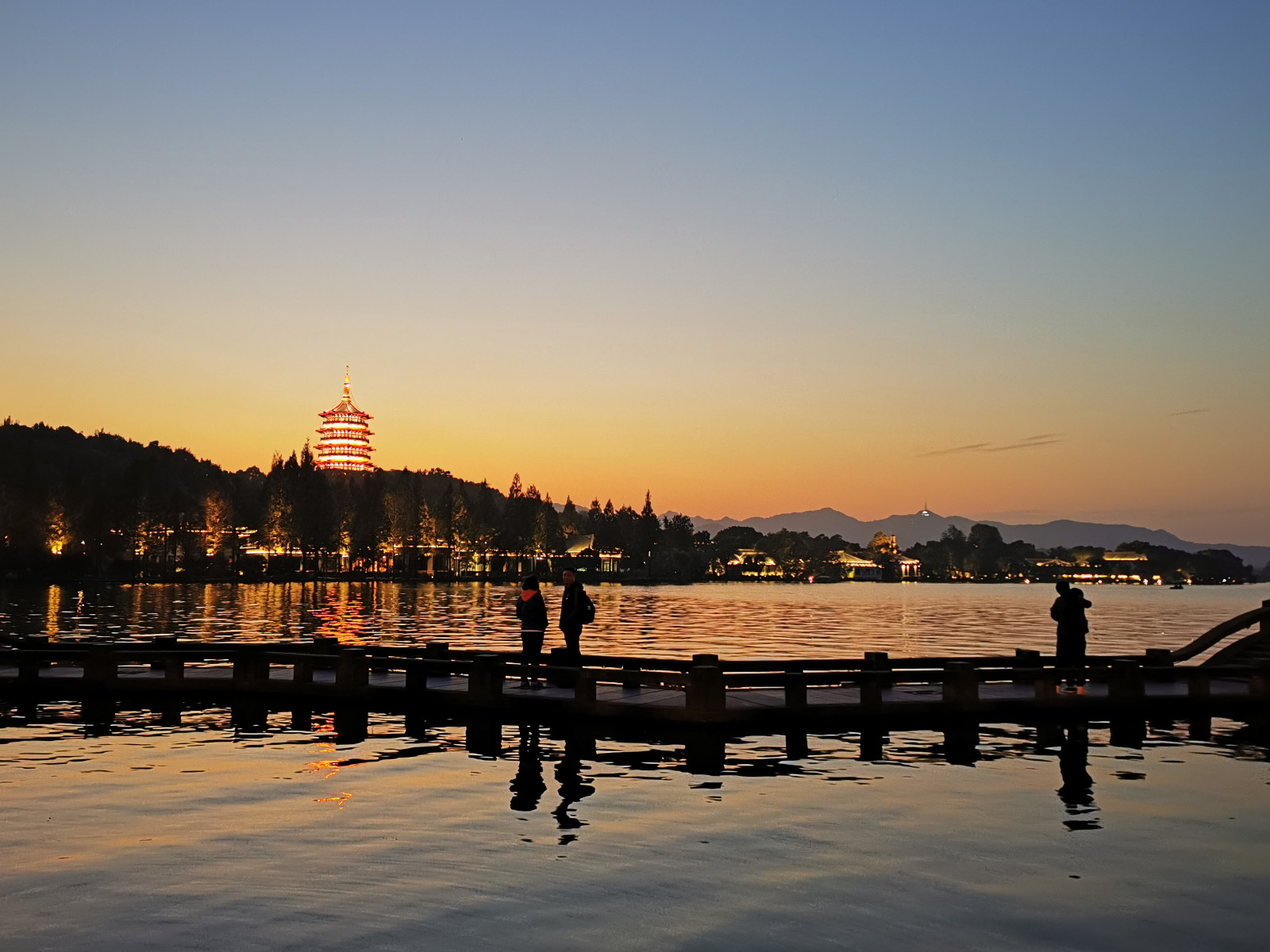
Overview of West lake
A
UNESCO World Heritage site since 2011, Hangzhou's premier tourist
attraction, West Lake (Xi hú ??) and its surrounding gardens, hills,
rockeries, temples, pagodas and parks have for centuries inspired poets,
officials and tourists with their beauty. This beauty pulls an
estimated 12 million domestic tourists and half a million foreign
tourists annually making it—and, consequentially, Hangzhou—one of
China's most tourist-heavy locales.
West
Lake(Xi hu) is located in the western area of Hangzhou City's center.
There are dozens of lakes called West Lake worldwide, but "West Lake"
usually refers to the Hangzhou West Lake. It is surrounded by mountains
on three sides. The average depth of West Lake is 0.8 meters, and the
capacity is about 14,290,000 cubic meters. The lake is divided by Gu
Shan, Bai, Su and Yanggong Causeways into five areas. Ordered by their
areas, they are Outer West Lake, West Inner Lake, North Inner Lake,
Little South Lake and Yue Lake. "Outer West Lake" is the largest. "Gu
Shan" or Gu Hill is the largest natural island in the lake. Su & Bai
Causeways run cross the lake. Three small man-made islands, "Xiao Ying
Zhou", "Hu Xin Ting", "Ruan Gong Dun" , lie in the center of Outer West
Lake. Thus, the basic layout is "one hill, two causeways, three islands,
and five lakes". West Lake is not only famous for its picturesque
landscape, it is also associated with many scholars, national heroes and
revolutionary martyrs, thus embracing many aspects of Chinese culture.
In addition, many ancient buildings, stone caves and engraved tablets in
surrounding areas are among the most cherished national treasures of
China, with significant artistic value.
History of Hangzhou West lake
Once
an inlet of the Qiantang River, it was written Emperor Qin Shi Huang,
the first ruler of imperial China, moored his boat at what is today West
Lake on his way to the sea. Build up of silt from river currents and
tide cut off the inlet and created a lagoon around the 4th century.
During the Tang Dynasty, the lake was twice its current size, and would
fluctuate over the centuries as West Lake periodically filled up with
sediment and mud and was dredged, drained and dyked.
Maintaining
the lake and dealing with droughts were two goals that shaped the
history of the lake. Attempting to control the water in the Tang Dynasty
during the late eighth century, governor Li Mi built wells and conduits
to send water from the lake into surrounding farmlands. Later, famed
poet and governor Bai Juyi built dykes and dams and had the Bai
Causeway, named after it's creator, built between Broken Bridge and
Solitary Island (Gu Shan). Another major causeway named for its
poet-governor creator, the Su Causeway, was built from mud gathered by a
massive dredging of West Lake by Su Shi in the Song Dynasty during the
late 11th century.
While West Lake languished in neglect during the Mongol-led Yuan Dynasty, it regained attention during the Ming Dynasty.
Dredging
was used to lengthen the Su Causeway and build the Yanggong Causeway.
The islands Xuxin Tang and Xiao Ying Zhou were also created and three
small pagodas, known as the Three Ponds, were built.
During their visits to West Lake, Qing Emperors Kangxi and later Qianlong composed their list of "Ten Scenic Spots" around.
West
Lake, which were pounced upon by local officials who erected steles
carved with replicas of the royal handwriting in the appropriate spots.
After the establishment of the Republic of China, renovation continued and resulted in the building of numerous parks around the lake. One such park, formerly the imperial hideaway Solitary Island (Gu Shan), was opened to the public and populated with monuments like the tomb of Qiu Jin.
Ten Scenes of West lake Hangzhou:
Traditionally,
there are ten best-known scenic spots on the Xi Hú, each remembered by a
four-character epithet. Collectively, they are known as the "Ten Scenes
of Xi Hú" (10 Scenic Spots in Xi Hú ????). Each is marked by a stela
with the epithet written in the calligraphy of the Qianlong Emperor.
They are:
Dawn on the Su Causeway in Spring (????)
Dawn
on the Su Causeway in Spring tops the list of the ten best known sights
in Hangzhou. The causeway was built during the Northern Song Dynasty by
Su Dongpo (1037-1101), a great scholar and famous poet, and was named
after him. Stretching 2.8 kilometers (1.7 miles), it includes six
bridges and is heavily sheltered by green vegetation. When spring comes,
the whole causeway is blanketed by peach blossoms and weeping willows,
creating an especially charming scene.
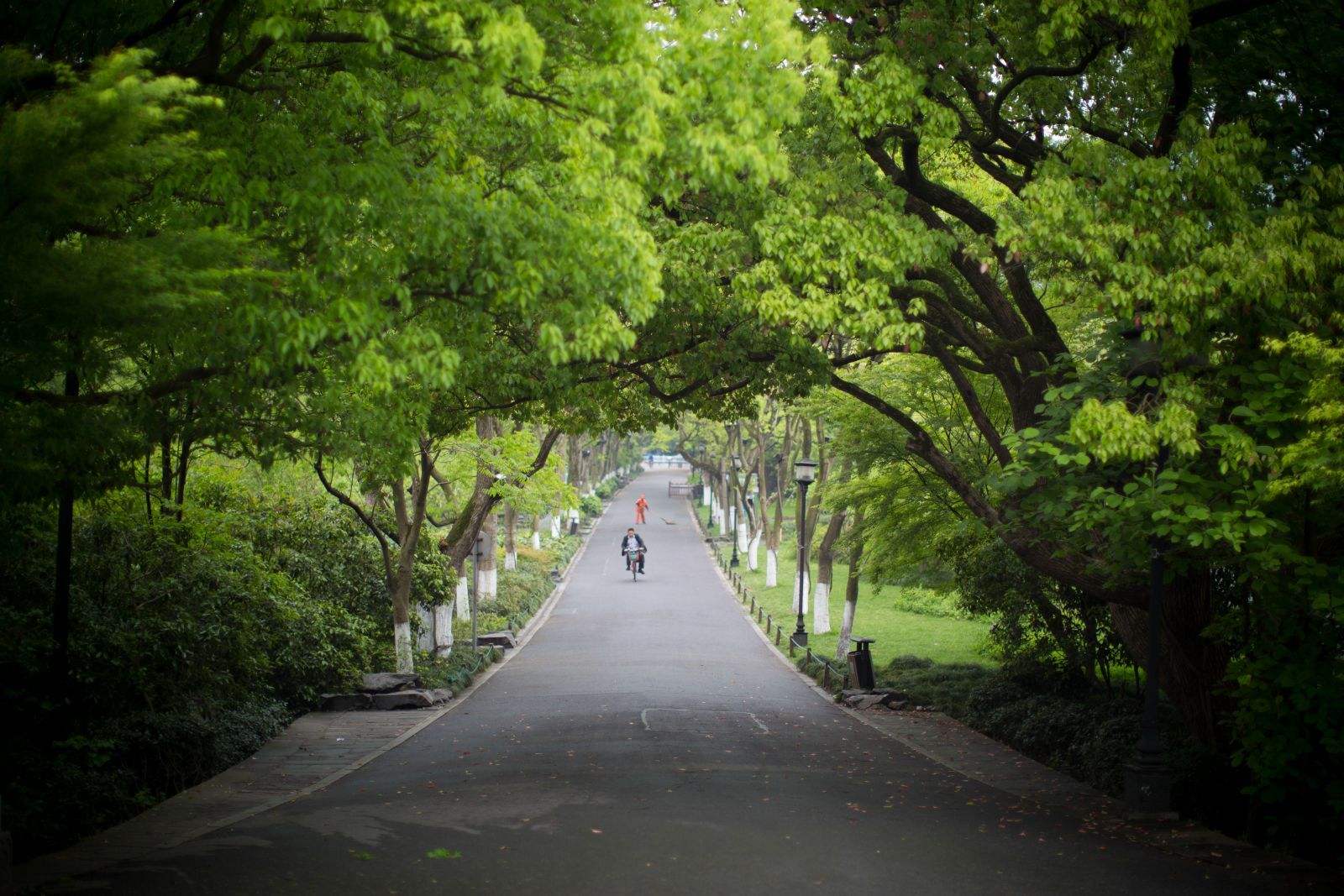
Curved Yard and Lotus Pool in Summer (????)
This
particular scene has earned its name from the fact that it had an
abundance of lotus plants growing along its shores, which was known as
Crooked Courtyard. It was also the location of a winery. The "perfume"
produced by the combination of the scent of lotus flowers and wine, to
which was added the scent of the cool breeze from the lake, was said to
be positively intoxicating. Though the winery is no more, the cool
evening breeze from the lake still blows and the lotus plants still
thrive along the shores of Crooked Courtyard, which has been converted
into a public park.
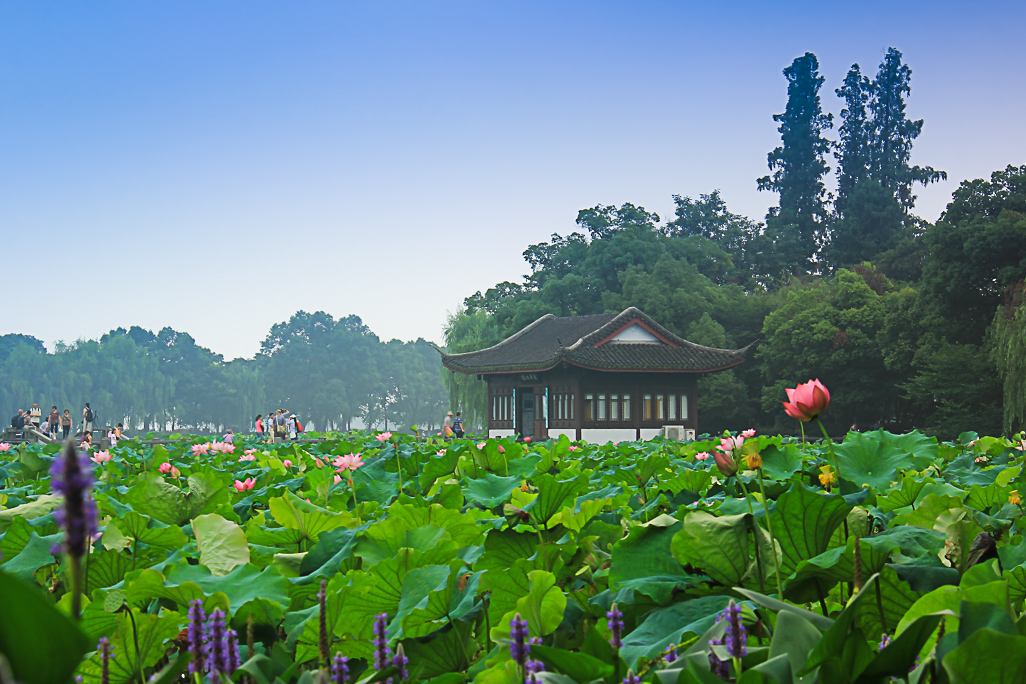
Moon over the Peaceful Lake in Autumn (????)
This
scene is seen from the western end of Bai Causeway. The teahouse with
its cement terrace bounded on three sides by water, became one of the
traditional places to view West Lake, especially on Mid-Autumn night
when the moon is full and bright, so it was named as "Autumn Moon on
Calm Lake". This scenic spot covers an area of 6000 square meters (7176
square yards). Various garden plants and flowers intermingle with
pavilions and platforms.
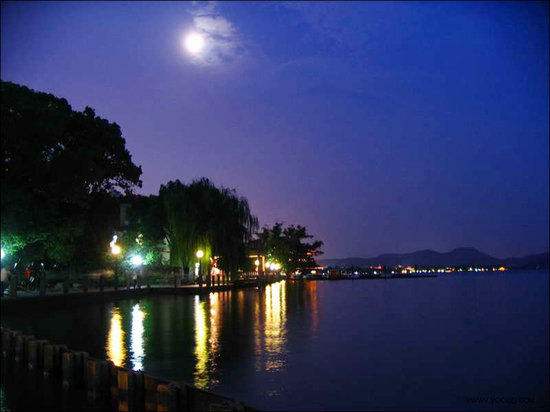
Remnant Snow on the Bridge in Winter (????)
The
most romantic, in origin, of the ten scenic sites is surely the one
called Melting Snow on Broken Bridge. According to legend, Broken
Bridge, which is not really broken, but is a traditional arched stone
bridge, is the site where two lovers, Xu Xian and a beautiful maiden,
who is actually a white snake, met and fell madly in love. In early
spring, when the snow begins to melt, it melts on one side of the bridge
first, due the fact that the other side is in shade, which gives the
bridge a split image. Viewed from a distance, it looks as if one half of
the bridge has been ripped off, since the snowy side blends perfectly
in with the surrounding landscape (hence the bridge's name)?
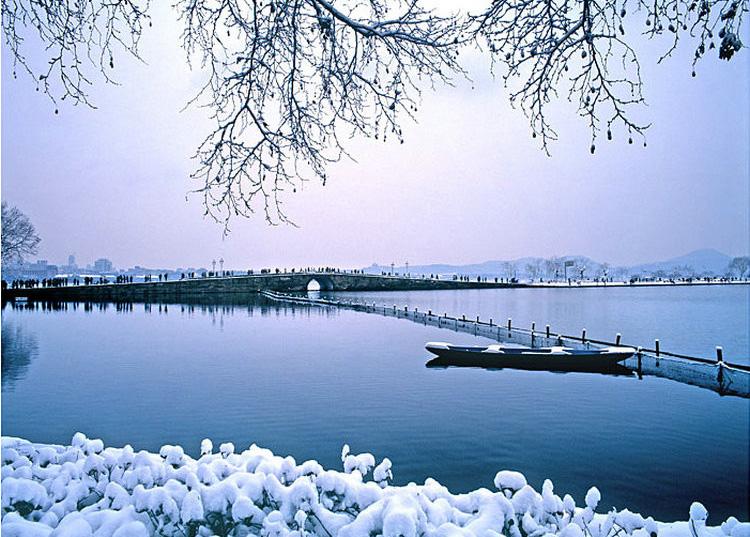
Leifeng Pagoda in the Sunset (????)
The
stone arched bridge is at the eastern end of the Bai Causeway. The
legendary tale of Lady White Snake took place here. After a snowfall,
the snow on the sunny side melts first, while snow on the shaded side
still lingers. Looking from afar, the bridge appears to be broken, thus
the name.
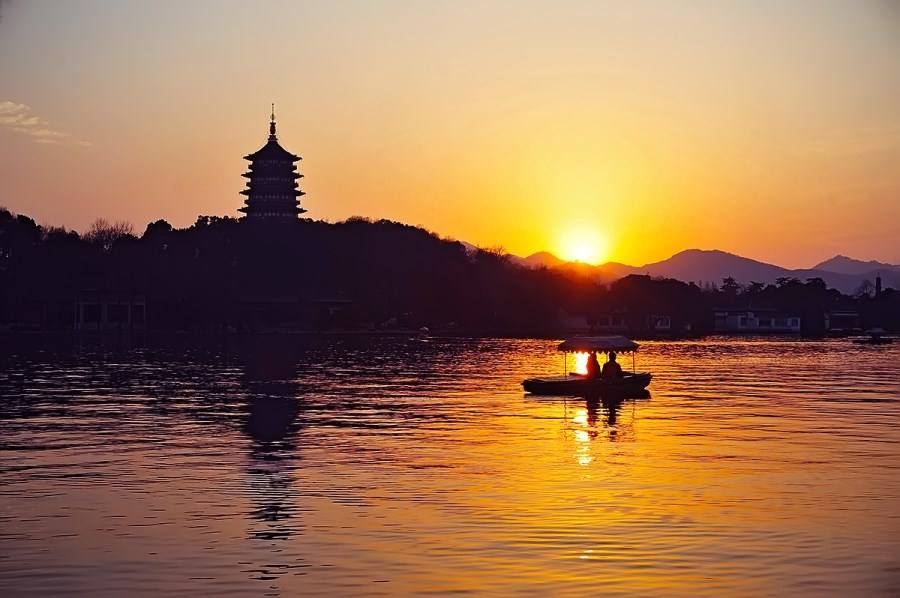
Two Peaks Piercing the Clouds (????)
Most
visitors to West Lake are so fascinated by the lake itself that they
often don't notice the surroundings. At the site called Twin Peaks
Piercing the Clouds, visitors are advised to also lift their gaze from
the lake's surface and behold the view on the other side of the lake,
where one is rewarded by the sight of two mountain peaks, separated by
the short distance of about five kilometers, at the northern rim of the
lake. On certain days with low-lying clouds, or on other days when a
low-lying fog is present, it is as if these twin peaks pierce through
the clouds, the fog, etc., hence the site's name.
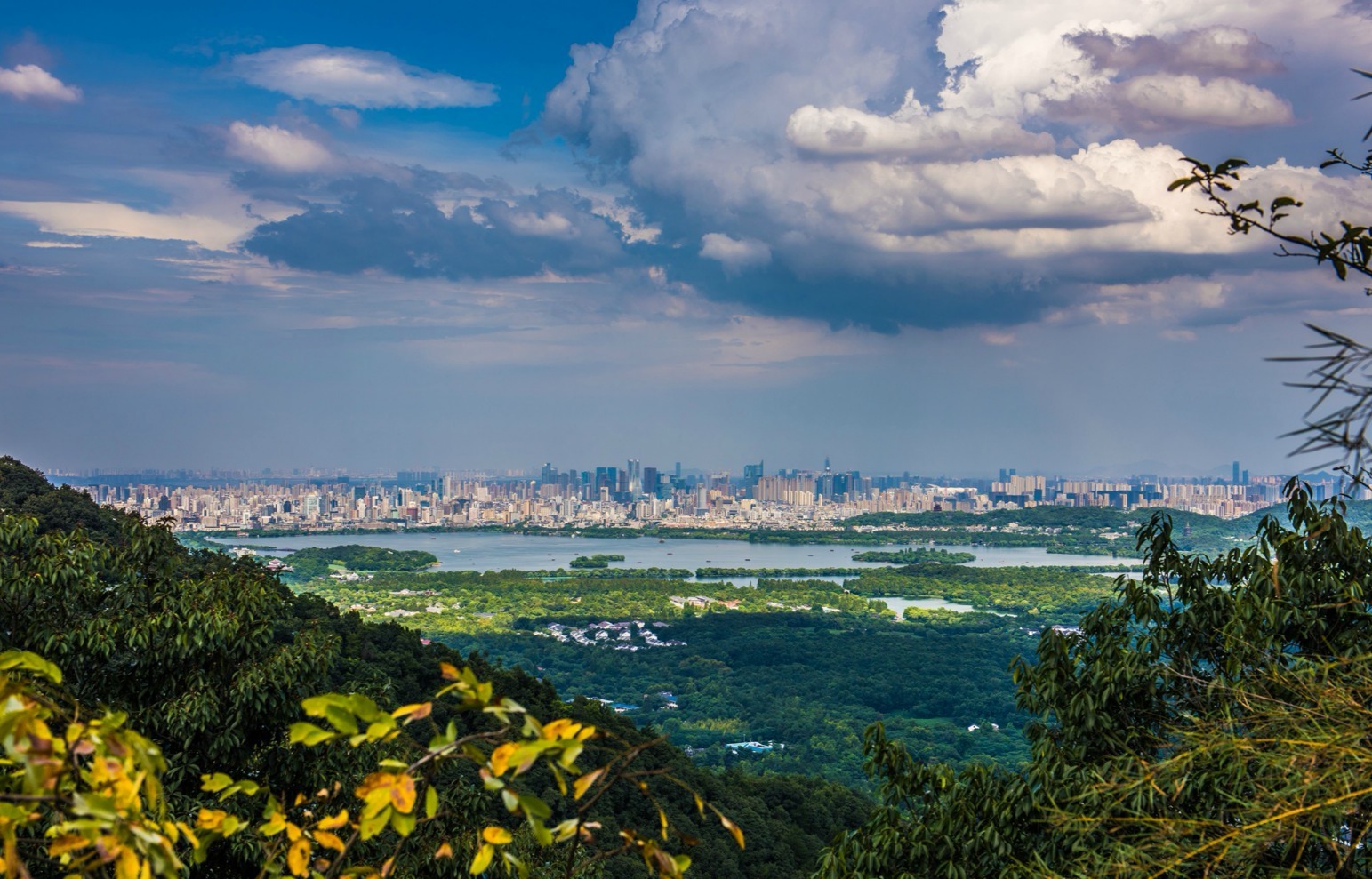
Orioles Singing in the Willows (????)
During
the Southern Song Dynasty, an imperial garden, featuring especially
weeping willow trees - which is almost always the perfect complement to a
seascape - was built on this site. The imperial garden has since become
a public park, replete with pavilions, bridges and lawns, and of course
the orioles still visit the willows, where they sing as beautifully as
when the emperor came here to listen to their song.
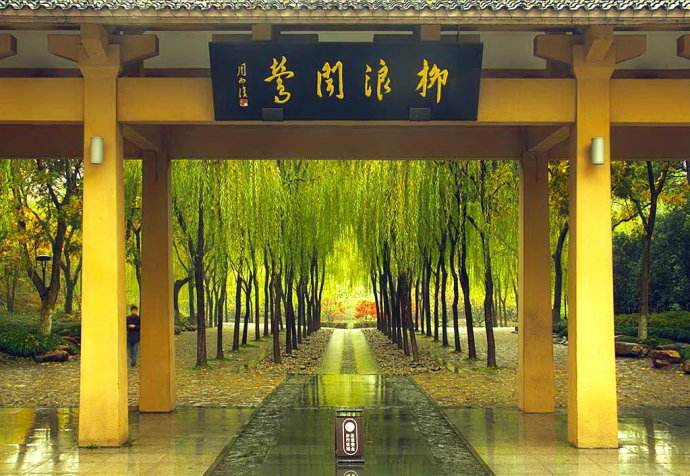
Fish Viewing at the Flower Pond (????)
This
spot is located at the southern end of Su Causeway. A clean stream
flows from Huajia Hill to join West Lake here, and many flowers grow
where the fresh water flows in, so it called "Flowery Harbor". This area
now has been made into a 22 hectare (54 acre) park with many varieties
of trees and flowers, featuring a peony garden which blooms in April and
a goldfish pond which is the famous site for viewing fish.
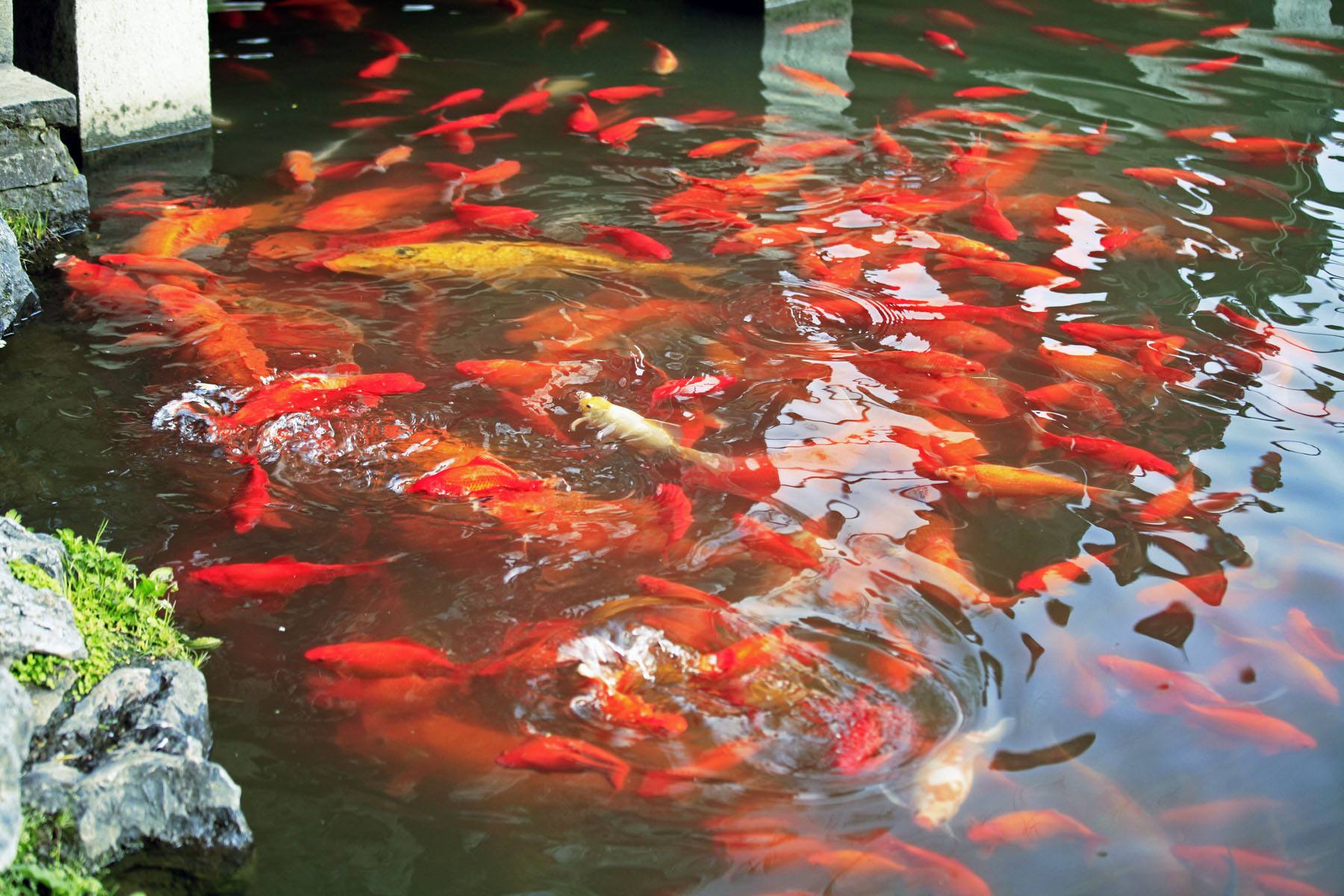
Three Ponds Mirroring the Moon (????)
Three
miniature stone pagodas, which act like beacons, built over 800 years
ago and 2 meters in height, are the centerpiece of the scenic spot
called "Three Pools Mirroring the Moon". To the west of Three Pools
Mirroring the Moon Island stand rounded hollow stone pagodas with five
round holes like windows around the top and bottom levels. On the night
of the Mid-Autumn festival, when the moon shines full and bright in the
sky, a candle is lit inside each of the pagodas. The light from the
holes and the moon cast their reflections on the water, hence the name.

Evening Bell Ringing at the Nanping Hill (????)
This
site, like most of the other sites at West Lake, is to be enjoyed to
its fullest under certain specific conditions; Evening Bell Ringing at
Nanping Mountain, as the name suggests, is to be enjoyed at dusk, when
the sun slowly sets, its softened rays casting their multi-colored
reflections on the surface of the lake. At this hour the huge bell of
Jingxi Temple peals, its clear, forceful sound reverberating across the
lake, as if amplified in the still evening air, calling for humility and
reminding Buddhists of their age-old religious heritage - and indeed,
reminding anyone who experiences this beautiful setting of his or her
ultimate smallness within the larger scope of things.
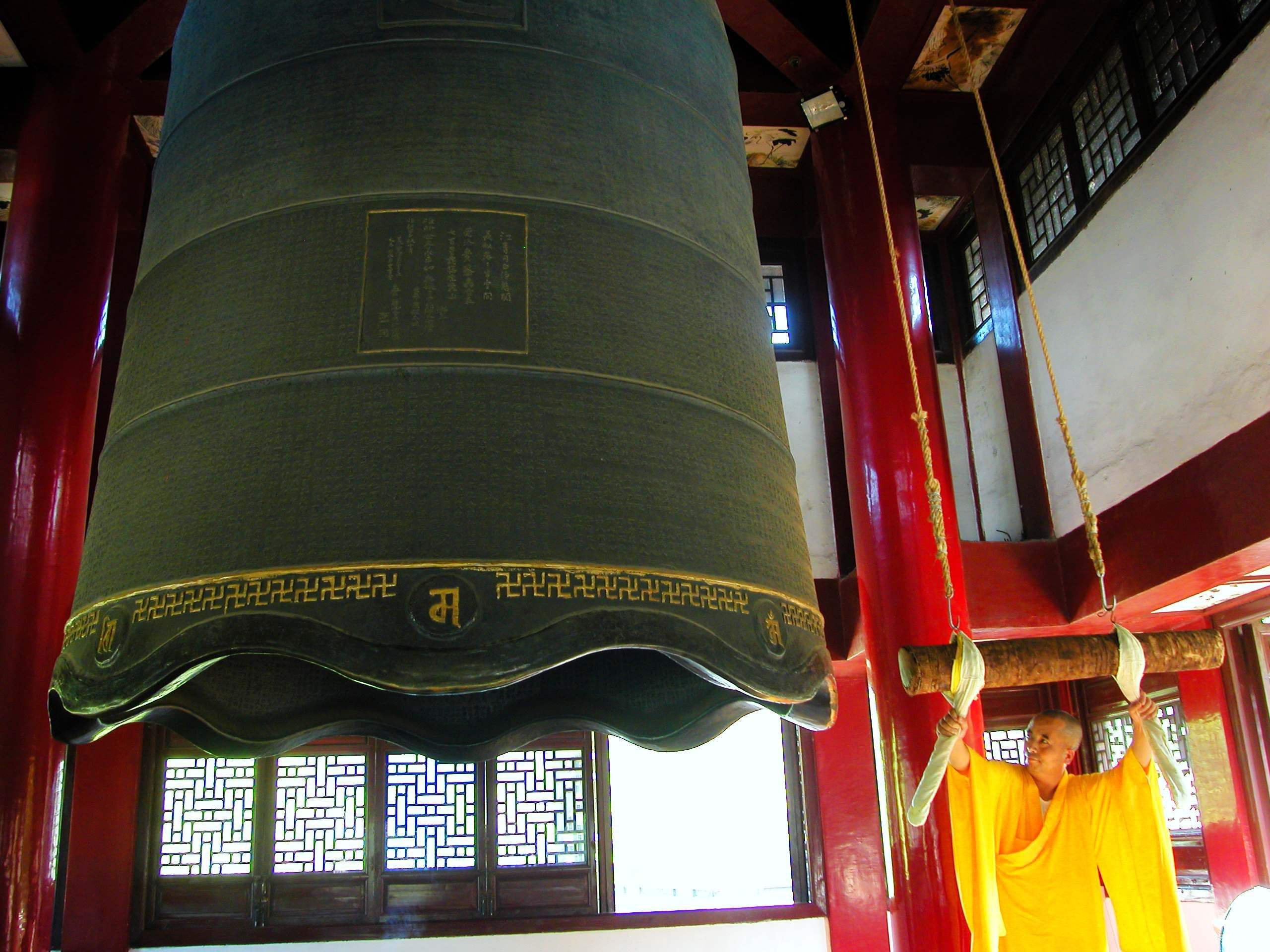
Prev: Yellow Mountains
Next: Yangzte River
Wechat: Chinaprivatetour
24 Hours Hotline:
+86 137-3541-1378
* Authentic Experiences: Genuine local experiences that immerse you in the true essence of Hangzhou and beyond.
* Safety First: Highest safety standards with secure activities and reliable transportation.
* Customizable Tours: Flexible itineraries tailored to your interests and needs.
* Local Expertise: In-depth knowledge of Hangzhou and China, offering exclusive insights.
* Professional Guides: Licensed bilingual guides with over 5 years of experience.
* Comfortable Travel: Experienced drivers and well-maintained vehicles for a smooth journey.
* Sustainable Tourism: Commitment to responsible tourism and supporting local communities.
* Customer-Focused: Personalized service and continuous improvement based on your feedback.
* Free Cancellation: Cancel up to 24 hours before travel for flexibility and peace of mind.
* 24/7 Support: Round-the-clock assistance for any questions or help needed.
1 to 1 tailor-made service from our professional travel advisors for the most sophisticated
Constantly excellent reviews for attraction, hotel and service Competitive price
Local experts provide quality tours Best selected knowledgeable local guides Authentic local restaurants
7*24 hours available to create you a worry-free tour. No Hidden Fees and absolutely no pressure to buy. Secured








Copyright © 2017 Hangzhouprivatetour.com All rights reserved.